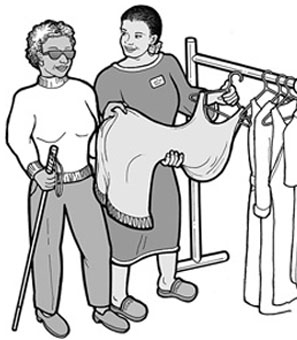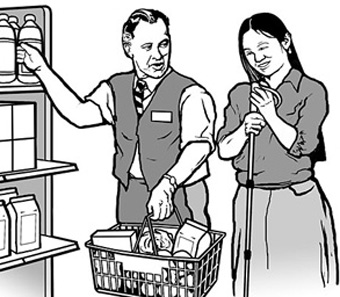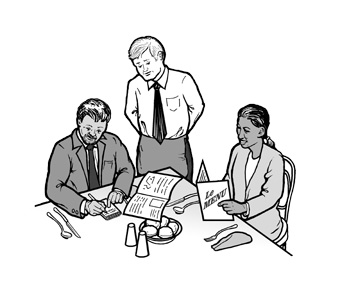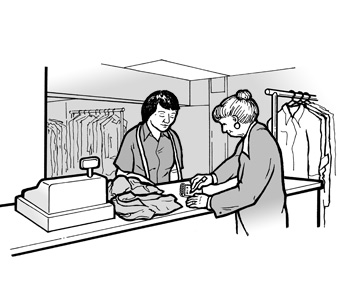



banner.jpg)


What visual information does your business provide?
Businesses that display merchandise, labels, or signs (but do not hand out printed materials) can usually conduct business successfully by speaking or reading information to a customer who is blind or has low vision. They can also assist a customer who is blind by locating and retrieving a product from a display shelf, describing the visual features of a product or the layout of an area, or helping the customer locate where to sign the credit card slip. Most businesses fall in this category.
|
|
|
Businesses that hand out simple printed materials have several options. A restaurant, for example, can have its waiters read the menu to a diner who is blind or can provide an audio recording of the menu. For customers who have low vision, the restaurant can have some menus printed in larger print or can keep a magnifying glass available for customer use (and a flashlight in low light situations). These techniques also work for small brochures, flyers, and other simple printed materials that are provided to customers. When these techniques are offered, it is not necessary to provide the materials in Braille.
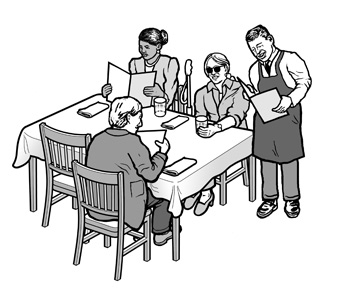
In a restaurant, a waiter is reading the menu to a woman who is blind.
Businesses that rely on printed materials to communicate extensive or specialized information must be prepared to deal with customers who use different techniques for absorbing printed information. Materials such as sales contracts or insurance policies should be made available in alternative ways, such as on a computer disk, in an audio format, in Braille, or in large print, so the customer can adequately study the information.
The important thing is to find out what technique(s) a particular customer can use. Some people who are blind have computer programs that convert written words into spoken words. Others use audio recordings in various formats. Some, but not all, people who are blind read Braille. Large print is useful for people who have some vision.

At a real estate office, a wife is reading a large print version of a sales contract
while her husband and the agent are reading regular print versions of the contract.
What oral information does your business provide?
For short, simple conversations, most businesses can successfully communicate with a customer who is deaf or hard of hearing by using gestures and notes.
|
In a restaurant, a man who is deaf is writing a note to ask the waiter how a certain dish is prepared. |
At a dry cleaner's, a woman who is deaf is writing a note to ask the staff person when her dry cleaning will be ready. |
For standardized tours and similar activities, businesses can provide a printed transcript of the words that are usually spoken, so the customer can follow along during the tour.
For legal or medical consultations; house, loan, or auto negotiations; training programs; and other extensive conversations, businesses must be prepared to deal with customers who use different techniques for absorbing oral information.

A car salesman is negotiating a sale with a couple. The husband listens while his wife uses a sign language interpreter to understand what the salesman is saying.
Generally, a sign language interpreter is required for complex communications when the customer’s primary method of communication is sign language. There are several sign languages used in the United States. American Sign Language (ASL, or Ameslan), Signed English, and Pidgin Signed English are the three most prevalent ones.
An oral interpreter may be required to communicate with a customer who has been trained to speechread (read lips). Normally, only about a quarter of English words can be seen on the mouth. An oral interpreter uses specialized mouth and hand gestures to reinforce what the speaker is saying to the customer.
“Real-time captioning,” also called “computer-assisted real-time translation” (CART) is a fairly new service for communicating with people who are deaf or hard of hearing. The transcriber takes down the speaker's words using either a stenography machine or a computer. Almost immediately, the words appear in text on a screen so the deaf person can “read” what the speaker is saying. This service is useful for people who can read and understand English.
Many people who lose their hearing later in life never learn sign language or speechreading. When it is necessary to communicate orally with a customer, face the customer, speak clearly, do not cover your mouth or chew gum, do not turn away while speaking, be sure your face is well-lighted, minimize background noise and distractions if possible, use gestures or point to printed information to reinforce what you are saying, and rephrase any statements the person does not seem to understand.
Video conferencing and other new technologies that provide immediate remote access to sign language interpreters, oral interpreters, and CART operators may soon provide easy and inexpensive ways to obtain interpreters and transcribers when needed.
|
|
|
|
|
|





